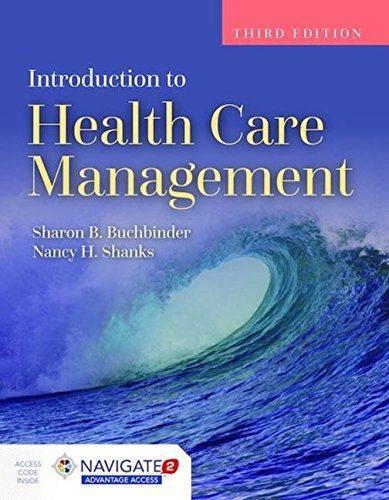Answered step by step
Verified Expert Solution
Question
1 Approved Answer
Please see attached for question and answer within the document. UNDERSTANDING HEALTHCARE FINANCIAL MANAGEMENT Chapter 12 -- Project Risk Analysis PROBLEM 3 California Health Center,

Please see attached for question and answer within the document.
 UNDERSTANDING HEALTHCARE FINANCIAL MANAGEMENT Chapter 12 -- Project Risk Analysis PROBLEM 3 California Health Center, a for-profit hospital, is evaluating the purchase of new diagnostic equipment. The equipment, which costs $600,000, has an expected life of five years and an estimated pretax salvage value of $200,000 at that time. The equipment is expected to be used 15 times a day for 250 days a year for each year of the project's life. On average, each procedure is expected to generate $80 in collections, which is net of bad debt losses and contractual allowances, in its first year of use. Thus, net revenues for Year 1 are estimated at 15 X 250 X $80 = $300,000. Labor and maintenance costs are expected to be $100,000 during the first year of operation, while utilities will cost another $10,000 and cash overhead will increase by $5,000 in Year 1. The cost for expendable supplies is expected to average $5 per procedure during the first year. All costs and revenues, except depreciation, are expected to increase at a 5 percent inflation rate after the first year. The equipment falls into the MACRS five-year class for tax depreciation and hence is subject to the following depreciation allowances: Year Allowance 1 0.2 2 0.32 3 0.19 4 0.12 5 0.11 6 0.06 The hospital's tax rate is 40 percent, and its corporate cost of capital is 10 percent. a. Perform a sensitivity analysis to see how NPV is affected by changes in the number of procedures per day, average collection amount, and salvage value. Remember supplies vary with number of procedures. b. Conduct a scenario analysis. Suppose that the hospital's staff concluded that the three most uncertain variables were number of procedures per day, average collection amount, and the equipment's salvage value. Furthermore, the following data were developed: Equipment Number of Average Salvage Scenario ProbabilityProceduresCollection Value Worst 0.25 10 $60 $100,000 Most likely 0.50 15 $80 $200,000 Best 0.25 20 $100 $300,000 c. Finally, assume that California Health Center's average project has a coefficient of variation of NPV in the range of 1.0 - 2.0. (Hint: Coefficient of variation is defined as the standard deviation of NPV divided by the expected NPV.) The hospital adjusts for risk by adding or subtracting 3 percentage points to its 10 percent corporate cost of capital. After adjusting for differential risk, is the project still profitable? d. What type of risk was measured and accounted for in Parts b. and c.? Should this be of concern to the hospital's managers
UNDERSTANDING HEALTHCARE FINANCIAL MANAGEMENT Chapter 12 -- Project Risk Analysis PROBLEM 3 California Health Center, a for-profit hospital, is evaluating the purchase of new diagnostic equipment. The equipment, which costs $600,000, has an expected life of five years and an estimated pretax salvage value of $200,000 at that time. The equipment is expected to be used 15 times a day for 250 days a year for each year of the project's life. On average, each procedure is expected to generate $80 in collections, which is net of bad debt losses and contractual allowances, in its first year of use. Thus, net revenues for Year 1 are estimated at 15 X 250 X $80 = $300,000. Labor and maintenance costs are expected to be $100,000 during the first year of operation, while utilities will cost another $10,000 and cash overhead will increase by $5,000 in Year 1. The cost for expendable supplies is expected to average $5 per procedure during the first year. All costs and revenues, except depreciation, are expected to increase at a 5 percent inflation rate after the first year. The equipment falls into the MACRS five-year class for tax depreciation and hence is subject to the following depreciation allowances: Year Allowance 1 0.2 2 0.32 3 0.19 4 0.12 5 0.11 6 0.06 The hospital's tax rate is 40 percent, and its corporate cost of capital is 10 percent. a. Perform a sensitivity analysis to see how NPV is affected by changes in the number of procedures per day, average collection amount, and salvage value. Remember supplies vary with number of procedures. b. Conduct a scenario analysis. Suppose that the hospital's staff concluded that the three most uncertain variables were number of procedures per day, average collection amount, and the equipment's salvage value. Furthermore, the following data were developed: Equipment Number of Average Salvage Scenario ProbabilityProceduresCollection Value Worst 0.25 10 $60 $100,000 Most likely 0.50 15 $80 $200,000 Best 0.25 20 $100 $300,000 c. Finally, assume that California Health Center's average project has a coefficient of variation of NPV in the range of 1.0 - 2.0. (Hint: Coefficient of variation is defined as the standard deviation of NPV divided by the expected NPV.) The hospital adjusts for risk by adding or subtracting 3 percentage points to its 10 percent corporate cost of capital. After adjusting for differential risk, is the project still profitable? d. What type of risk was measured and accounted for in Parts b. and c.? Should this be of concern to the hospital's managers Step by Step Solution
There are 3 Steps involved in it
Step: 1

Get Instant Access to Expert-Tailored Solutions
See step-by-step solutions with expert insights and AI powered tools for academic success
Step: 2

Step: 3

Ace Your Homework with AI
Get the answers you need in no time with our AI-driven, step-by-step assistance
Get Started


